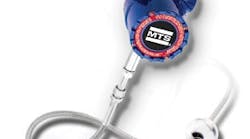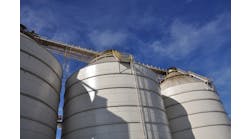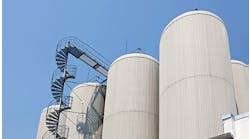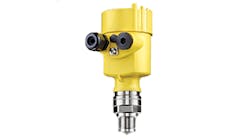Creal Springs, Ill., and he’s had 16 Level Plus transmitters in place since the terminal began operating in 2001. These units check refined product levels at Creal Springs and two other nearby facilities. Wiese says three major oil and gas transmission lines intersect here, and the largest, a 26-inch from TEPPCO and Marathon Oil in Beaumont, Texas, comes straight into his terminal.
“The Level Plus units get us to within 1/100 of an inch of the exact amount of product we have in each tank, and reports back via our HMI,” says Wiese. “Besides precise volume, we also get temperature data, which is important because ambient temperatures can affect that volume. These gauges have to very accurate, and they are.”
Wiese adds that Level Plus’ 50-foot flexible tank cable is easier to replace than the rigid pipe that goes with the GSI gauge he has on one tank. Connected to a flange at the top of the tank, this cable has built-in resistive temperature devices (RTD) spaced along it, and its gauge is in a float that moves along the cable as it sits on top of the product.
“I can change out the flexible cable myself in an hour and a half because it’s rigidly mounted, but it’s flexible until it reaches to the bottom of the tank where the float and sensor is. I can just pull and replace the sensing element, update the software, and be back up in 90 minutes,” says Wiese.
Wiese acknowledges there have been a few RS-485 bus network and lightning-related issues that meant replacing two or three communication boards. “We’re on solid rock and it’s hard to ground our systems, so we added some surge protection and lightening arrestors this past spring, and our failures are down to none” adds Wiese. “Overall, we couldn’t be happier with MTS’ transmitters, and their support has always been available and very helpful. MTS recently told me we’ll be able to do wireless, and so we’re studying that now, too.”
To measure other precious liquids, Lawrenceburg Distillers Indiana uses about 100 Level Plus M Series transmitters in about half of its 500 blending and finishing tanks. These tanks previously used D8 solid-rod gauges that had mostly local displays, but there were ongoing arguments about what was on the very bottom of tanks where there was no indication, according to John Netzley, Lawrenceburg’s power and control engineer.
“With the M Series we get digital data, high accuracy, no drift and remote readings,” says Netzley. “This is especially important for us because we’re highly taxed—about $17 per 50-gallon barrel of 100-proof product—and we must calculate inventory and taxes. So we need to know temperatures, and Level Plus’ embedded RTDs give us very good temperature readings and precise volumes within 1/100th of an inch, so we can better determine zero levels.”
Tom Horn, terminal manager at BP’s terminal in Fairfax, Va., reports that his six above-ground tanks receive finished gasoline and diesel via a 24-inch line from BP’s Texas City refinery. He adds that 10 Level Plus transmitters were added to his tanks about three years ago, and that they’ve been accurately measuring volume and temperature since then. “Level Plus measures to less than 1/10 of an inch for us, and previously we could only get to 1/8 inch. We also get net gallons, gross gallons and temperature readings that show us how close we are to 60 °F,” adds Horn.
“This 20% better accuracy helps with inventory and scheduling because we can make more accurate forecasts about the product we’re going to need,” explains Horn. “When product is delivered, the real-time tank data comes through our office HMI, and we can watch the tanks fill up, which is nice for our operators. ”
Horn adds that data from MTS’ transmitters also is tied to the Fairfax terminal’s Top Tech automated loading system, so staff at BP’s headquarters in Chicago can check inventory and make forecasts as well.




